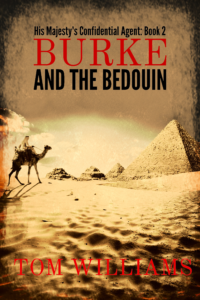 My guest today is Tom Williams
My guest today is Tom Williams
When Deborah suggested I write about an object associated with Burke and the Bedouin (published by Endeavour Press), I really struggled to think of one. The story does feature the odd camel (there’s a clue on the cover) but I felt that an olivewood carving dating from a trip to Israel in 1972 didn’t really count. What objects are there that have intimate associations with Napoleon’s ill-fated invasion of Egypt in 1798? It’s not as if I have any Middle-Eastern Napoleonic artefacts lying round the house.
I don’t, but the impressive Napoleon exhibition at Les Invalides in Paris has a few. When I visited, I think that one of the ones that impressed me most was Napoleon’s telescope.
Ironically, the telescope was made in Britain, but it is supposed to be the one that he used in the Battle of the Pyramids, which features prominently in my book. The Battle of the Pyramids did not actually take place at the pyramids, but they were visible from the site of the battle and “the Battle of the Pyramids” sounds a lot better than “the battle quite near the Nile where you could see the pyramids on the horizon”. There’s not that much interest in it in England, as no British forces were involved, but it was a conclusive affair, ending Mameluke rule in Egypt. When I visited the pyramids, I was able to look towards the Nile and imagine the vast Mameluke army riding across what is now a Cairo suburb, before being turned by the French and driven to their deaths in the river. In Paris I was amazed to look down on the telescope through which Napoleon would have surveyed the fighting. For good measure there is an Arab dagger in the same case, which was also owned by Napoleon. It’s obviously a presentation item, though, rather than a working item, so I feel the telescope brings you closer to the man. Napoleon (like most generals of the time) was a very ‘hands on’ leader and he would have watched the battle, staff officers riding to carry his orders to the units engaging the enemy. A good telescope was an essential tool of his trade.
 After the Battle of the Pyramids, Napoleon was able to occupy Cairo, the remaining Mamelukes retreating south along the Nile. It’s quite possible that Napoleon plans to march his men overland into India. He even suggested that some sort of canal might be possible and engineers did some test diggings which were remarkably close to the modern site of the Suez Canal.
After the Battle of the Pyramids, Napoleon was able to occupy Cairo, the remaining Mamelukes retreating south along the Nile. It’s quite possible that Napoleon plans to march his men overland into India. He even suggested that some sort of canal might be possible and engineers did some test diggings which were remarkably close to the modern site of the Suez Canal.
Napoleon’s conquest of Egypt could have been a strategic masterstroke for France, but the destruction of his fleet at the Battle of the Nile left the Army isolated. Nobody knows why the French left their Navy exposed and vulnerable against the Egyptian sure, but Burke and the Bedouin does suggest one possible solution. Although the book is fiction, the idea that Napoleon’s orders for his admiral may have been intercepted en route may well be true. Could it have been the work of a British spy? We will never know.
Burke and the Bedouin is a light-hearted (if occasionally violent) romp where Burke finds himself alone and pitted against the might of Napoleon’s invasion force. Not that he lets a little thing like saving Egypt’s from French domination get in the way of his attempts to free Spanish slave Bernadita from her cruel Turkish master. As in Burke in the Land of Silver, swashes are buckled and bodices ripped before Burke wins the day for Britain. While Burke’s adventures this time are entirely imaginary, the historical background is not. The details of Napoleon’s invasion, the Battle of the Pyramids and the destruction of the French fleet all draw heavily on contemporary accounts.
James Burke: making the history of the Napoleonic Wars painless (and even fun).
Read more about it from Tom in Historia

Sounds like a fascinating, well researched book. Thanks for sharing:)